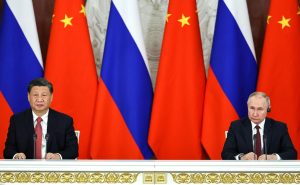Chinese President Xi Jinping traveled to Moscow on a three-day state visit last week, his first foreign trip since he began his third term as president. The visit was clearly a show of support for Russian President Vladimir Putin, but what the visit got Putin in concrete terms is unclear.
Ever since the Russian invasion of Ukraine more than a year ago, Russia has been largely cut off from the West in economic and diplomatic terms and is being treated like a pariah state. Given that Putin was recently indicted by the International Criminal Court (ICC) for war crimes, Xi’s visit is probably noteworthy. Both leaders have a shared disdain for the U.S. and the liberal world order, but Russia is no equal to China and their comradery is an unequal alliance. The visit therefore probably stamps China’s standing as a big brother to Russia.
The visit was also clearly of importance to Xi, who is locked in a geopolitical contest with the United States. As many analysts have noted, the U.S. and China look at each other “as the primary, if not geopolitical threat, then at least rival for power, influence, and effective domination of both geopolitics and economics in the 21st century.” Therefore, for Xi, the visit and China’s broader relationship with Russia is also possibly an effort to undermine the United States and the West.
During the visit, Xi and Putin signed a fairly detailed joint statement. The statement contained a lot of the standard talking points, but a few elements stand out. It noted that the China-Russia bilateral relationship is unlike “the military and political alliance during the Cold War, but transcends this model of state relations, and has the nature of non-alignment, non-confrontation, and non-targeting of third countries.” The idea of non-confrontation and non-targeting of third countries is breathtaking in the face of the Russian invasion of Ukraine and China’s continuing harassment of its neighbors in the Indo-Pacific and beyond.
The statement also noted that Russia “needs a prosperous and stable China, and China needs a strong and successful Russia,” which is a reflection of what the two would like the world order to become. The statement also stated that “hegemonism, unilateralism, and protectionism are still rampant, and it is unacceptable to replace recognized principles and norms of international law with a ‘rule-based order.’”
Curiously, the statement did not reiterate the “no limits and no forbidden areas” formulation that had previously appeared, in particular after the February 2022 summit that was held just prior to the invasion of Ukraine. It’s unclear if this is a good thing or not, whether there were differences over such a formulation or whether the two leaders think they have now gone beyond needing to state it. But it was notable that the statement said they will provide complete support to each other “in safeguarding our respective core interests, first of all on issues of sovereignty, territorial integrity, security, and development.”
This suggests some expectation of reciprocity, of Russian support for China’s territorial claims in Asia in return for China’s support for the Russian claims in Ukraine. This will be a cause for worry in the Indo-Pacific. This is especially true for India, which maintains a close relationship with Russia despite its invasion of Ukraine, and has taken some flak for it from its Western partners. The statement also criticized American claims about democracy and human rights, not surprising for leaders of two countries which have both been accused of engaging in genocidal actions.
As regards the Indo-Pacific, the statement criticized in all but name the Quad grouping, though this was supposedly aimed at the U.S. and its strategy in the region. This is not new, of course, with Russian Foreign Minister Sergey Lavrov publicly criticizing the Quad while in India, which is in the unique position of being both a friend of Russia and a member of the Quad. Indian officials were not pleased and did reluctantly express their unhappiness at such a blatant disregard for Indian sensitivities, but Moscow’s views clearly have not changed. The statement was less coy about AUKUS, which was roundly opposed as a violation of nuclear non-proliferation, in China and Russia’s view.
Despite the visit, what the two sides will be willing to do for each other beyond diplomatic comfort remains to be seen. One concern is the possibility of Chinese arms sales to Russia to prop up its failing invasion. Both the U.S. and Europe have warned that such a move is a “red line” that might further hurt their China ties. Whether that will have any impact on China’s decision-making will be known in the coming weeks and months, considering that the war is expected to continue for some time.
Also unclear is whether Xi will attempt any mediation between Russia and Ukraine. There have been some noises to this effect, including a 12-point point Chinese peace proposal that was remarkably self-serving and one-sided. While Ukraine appears interested, no contact appears to have been made yet. But given the Chinese perspective on the war, it is unlikely that this will go forward in any case.
Ultimately, the summit may reflect the difficult position that the two countries find themselves in. A year after the Russian invasion, the West is much more united, U.S. alliances in the Indo-Pacific are strengthening, and there is greater pushback against China in the Indo-Pacific. Neither Russia nor China have very many other friends, at least none that can add any strength to their respective efforts to counter the West. Thus, Russia and China need each other more than either probably expected.

































